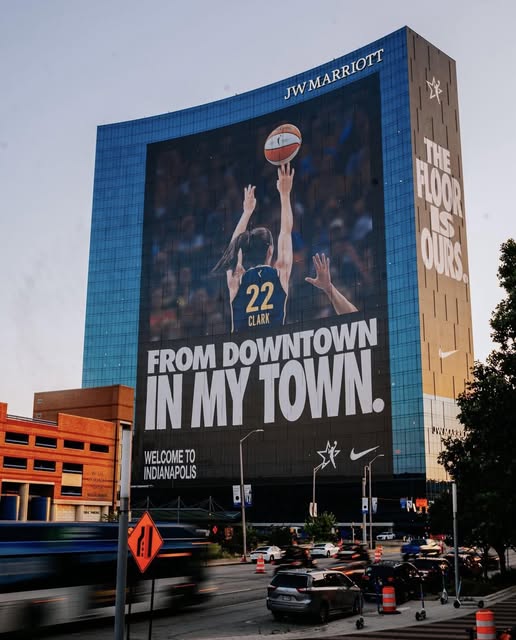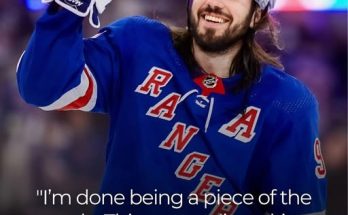The JW Marriott Indianapolis has once again demonstrated its unmatched ability to become a citywide canvas for sports and cultural spectacle, this time unveiling the largest sports graphic ever displayed on the hotel. Towering more than 200 feet tall and stretching across tens of thousands of square feet of windowed façade, the meticulously planned installation spans the iconic curved glass wall and transforms the luxurious 34‑story building into a phenomenal visual landmark.
Dominating the skyline, the graphic commemorates the arrival of Indiana Fever rookie Caitlin Clark, celebrating her arrival in the WNBA and the profound optimism she’s sparked in Indianapolis sports culture. Installed by local firm Sport Graphics Inc., the campaign features a 205‑foot‑tall portrait of Clark dribbling, emblazoned with the bold slogan “Is It In You?” along with prominent Gatorade and Fever logos. As the first time a commercial product ad—with obvious branding—has been allowed on the facade, it signifies a pivotal moment: the JW–Marriott exterior now serves not only as promotion of city events, but also as a strategic component of brand storytelling .
The logistics behind the unveiling are staggering. Sport Graphics printed the oversized decal using roughly 400 rolls of vinyl, each more than 50 inches wide and extending to 1,000 feet long. Installation required teams working from custom davit arms, abseiling down 31 stories to meticulously apply panels piece by piece. The entire process stretched across several days, beginning in late June and extending into July, culminating in a flawless, seamless finish .
This project does more than honor a rising star—it underscores Indy’s ongoing evolution into a major hub for spectator events and immersive branding. For years, the hotel has partnered with Sport Graphics to present jaw‑dropping visuals for marquee events. Past installations include the 2012 Lombardi Trophy for Super Bowl XLVI, the 2015 NCAA Tournament bracket—which held a Guinness World Record at the time—and the 100th Indianapolis 500 Borg‑Warner Trophy in 2016, each covering more than 70,000 square feet and earning national attention .
Among these is the iconic NCAA bracket displayed in spring 2021. The immense 47,000‑square‑foot bracket spanned 165 feet tall by 267 feet wide, held Guinness World Record status, and took over 100 hours to print and five days to install—proof of what Indy can achieve when creativity meets ambition .
These jaw‑dropping promotions are more than aesthetics—they’re major business accelerators. For instance, during the 2015 Final Four, the bracket installation ranged across nearly 44,000 square feet and earned an estimated $391,000 in media value, given its recurring presence on national broadcasts . Similarly, during Super Bowl XLVI, coverage of the giant Lombardi Trophy generated over $250,000 in equivalent advertising exposure . In effect, the JW – Marriott becomes a giant unpaid billboard with international reach every time Sport Graphics undertakes these projects.
In comparison, the Caitlin Clark moment marks a shift. Unlike logos and trophies, this installation is a full‑on commercial advertisement—sponsored by Gatorade. Hotel management made it clear this is a one‑off event, born of Clark’s meteoric popularity and her deepening roots in Indy’s sports fabric: “We don’t want the building to become a regular billboard for general advertisements… only when there’s something significant happening for the city” . This curated approach reflects deliberation rather than commercialization, preserving the structure’s cultural cachet.
The synergy extends beyond promotion. A giant QR code towered on the façade during the NBA All‑Star graphic in early 2024—an interactive element that engaged fans and drove digital interaction—with QR brownies measuring 40 × 40 feet, likely some of the largest ever . Motorized davits, squeegee‑applied vinyl, and waterproofing measures underscore the technical finesse required to bring these massive campaigns to life—all on the concave wall’s 400 feet of glass in a matter of days .
Cities like Indianapolis gain major intangible advantages from these spectacles. They build city pride (“This is Indianapolis”), heat up the streetscape, and create iconic visual moments broadcast worldwide. Sport Graphics has been the mastermind behind each effort since 1986, growing from a print shop into a cultural force that anchors the city’s sports and event identity . Their collaboration with partners like IMS and NBA transforms city buildings into living, monumental canvases.
For tourists, fans, and locals alike, the JW‑Marriott facade is no longer just part of a skyline—it’s a decade‑long visual timeline of accomplishments, a gallery of memories that maps Indy’s rise as a destination city. From IndyCar to basketball to pop culture icons, each graphic signifies a milestone in the city’s evolving story.
Standing 34 stories tall, featuring over 1,000 rooms and the Midwest’s largest hotel ballroom, JW Marriott is structurally ideal for such installations; the curved, high‑rise façade provides a sprawling, luminous canvas that designers and marketers across the country envy .
Clark’s mural, larger than life and strategically positioned, represents both personal triumph and sports marketing ingenuity. A rookie making her WNBA debut, backed by national exposure, poised behind a slogan rooted in grit—it’s the perfect storm of athlete narrative and brand momentum.
Looking ahead, the potential seems limitless. If Indy attracts future global events—such as the Olympics trials, more NCAA tournaments, or big‑name performers like Taylor Swift—expect the JW‑Marriott to morph again, shifting identities with the city’s heartbeat. Already, Sport Graphics is preparing for multiple upcoming campaigns: Olympic qualifying events, All‑Star promotions, and more, with the next chart‑topper likely already in conceptual stages .
In transforming a hotel into the world’s stage for sports branding, JW Marriott and Sport Graphics have redefined how cities celebrate athletes, brands, and cultural moments. From the heights of basketball brackets to the gaze of IndyCars, these visual feats have made the facade a magnet for the public eye. Whether commemorating legends or launching rookie careers, the effect remains electrifying, unforgettable, and emblematic of Indianapolis’s confidence on the global stage.
In the end, this is more than architecture—it’s storytelling writ large. For Indy, every event is a chapter; for the JW, every façade, a page. And Caitlin Clark’s arrival, emblazoned on one of the largest sports graphics in history, proves that when a city dreams big, it paints even bigger.




